What to Feed Senior Cats With High Bun
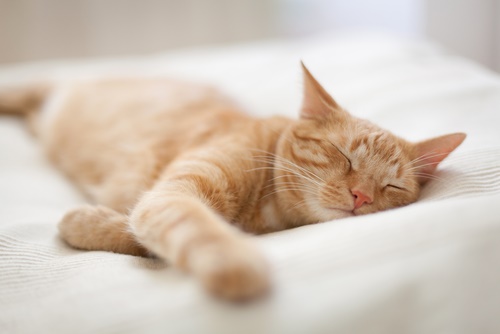
Our Review Process
Our reviews are based on extensive research and, when possible, hands-on testing. Each time you make a purchase through one of our independently-chosen links, we'll receive a percentage of the proceeds. Read more about how we're supported here.
Dietary management can't turn back the clock on kidney disease, but it can make the future brighter. Feeding your cat the right food is the best way to slow the disease's progression, minimize symptoms, and give your cat the best life possible.
At A Glance: Best Food To Buy For Cats With Kidney Disease
Want a quick look at the products reviewed in this article? In the comparison table below, we've highlighted some of the most important features of each product. You'll find more detailed information about each product later in the article.
Overall Best Non-Prescription
Runner-Up Non-Prescription
Because it's low in phosphorus with controlled sodium, added B vitamins, and anti-inflammatory omega-3s, we recommend Royal Canin Veterinary Diet Renal Support D Morsels in Gravy as the overall best cat food for kidney disease. This product has a strong reputation for helping cats with chronic kidney disease (CKD), but it's far from perfect.
To help you find the right match for your cat, we've gathered eight very different formulas, including prescription and non-prescription options, dry kibble, and one raw recipe.
Before we get into the reviews, a quick disclaimer:
This article is not a substitute for veterinary advice. Your veterinarian can provide personalized suggestions relevant to your cat's unique situation.
Years of scientific research and experience have left CKD cat guardians, seasoned veterinarians, and scientists with more questions than answers. As much as I wish it could, this article can't give you all the pieces to the feline CKD puzzle.
It will, however, help you understand the complex dynamics between diet and disease. You should walk away from this article feeling less overwhelmed and more confident about your ability to make the right choices for your cat.
You'll find out why food matters, learn what goes into a great diet, and read reviews of the best foods for cats with kidney disease. Let's start with the key principles of feeding a cat with CKD.
Look For Foods With Restricted Or High-quality Protein
When dietary protein breaks down during digestion, it produces waste. One of these waste products is urea. Healthy kidneys filter out this waste and send it on its way into the litter box.
But as your cat loses kidney function, it becomes increasingly difficult to remove these waste products. Instead of passing through your cat's body, they remain in the bloodstream.
This is why blood urea nitrogen (BUN) levels rise in cats with CKD. BUN is a measurement that veterinarians analyze on routine bloodwork to evaluate kidney health.
In an attempt to reduce BUN levels, cats with CKD are often given protein-restricted foods. But in recent years, this practice has become increasingly controversial.
Experts worry that a protein-restricted diet will lead to severe protein deprivation, decreased muscle mass, and poor physical condition. Instead of cutting back to 20% or fewer calories from protein, you may choose to feed moderate levels of highly digestible, low-waste protein from high-quality animal sources.
The bottom line is that you want your cat to feel better, not worse. Although a protein-restricted diet helps some cats feel better, it may also lead to muscle wasting and weakness. You'll have to weigh the costs and benefits of a low-protein diet for your cat.
Choose Foods That Are Low In Phosphorus
As kidney function declines, phosphorus is one of the things that doesn't get filtered out. As phosphorus builds up in the bloodstream, your cat will start to feel ill and kidney function declines even more quickly.
The best way to counteract this effect is to reduce the amount of phosphorus in your cat's diet. The ideal diet for a cat with CKD contains less than 0.5% phosphorus on a dry matter basis.
The Best Cat Food For Kidney Disease Has Relatively Low Sodium Content
Because excessive sodium consumption can increase blood pressure and worsen kidney damage, most renal (kidney) diets are low in sodium. You'll also want to avoid any high-sodium treats like lunch meat and salty cheese.
Reduce Inflammation With Omega-3 Fatty Acids
Many cats with kidney disease develop nephritis, which is inflammation of the kidneys. Along with other anti-inflammatory supplements, consider omega-3 fatty acids like EPA and DHA. These fatty acids have a well-documented ability to reduce inflammation, helping your cat to feel better.
Although humans and other animals can benefit from omega-3 fatty acids derived from plant sources like flaxseed oil, cats can only utilize those found in animal fat. Good sources include various types of fish oil—like salmon oil, menhaden fish oil, and sardine oil—as well as krill oil. You can also consider green-lipped mussels. In addition to being a good source of other omega-3s, they're the ocean's most concentrated source of the fatty acid ETA.
Although many foods contain sources of these beneficial fatty acids, you may also want to supplement your cat's diet with a good omega-3 supplement.
Good Foods Give Your Cat Extra B Vitamins
Because cats with kidney disease urinate so much, they often lose crucial B vitamins in the litter box. Deficiency in B vitamins is associated with loss of appetite and overall poor health.
Prescription or therapeutic diets for kidney disease are usually fortified with additional B-complex vitamins. Your veterinarian may also recommend B12 shots to give your cat a boost.
In addition to vitamins in your cat's diet and subcutaneous injections, consider giving your cat a multivitamin supplement like Vetoquinol Renal K+. Formulated for cats and dogs with kidney disease, this gel contains B-complex vitamins and potassium. Both substances support muscle function and your cat's nervous system health.
Hydration Is Essential
Kidney disease causes cats to urinate excessively and lose their appetites, so dehydration is common among cats with the condition. Many cats rely on subcutaneous fluid injections (injections under the skin) to stay hydrated, but there's more than one way to increase your cat's water intake.
Wet food is 70% water or more, making it an effortless source of the hydration your cat needs. If you're currently feeding a dry diet, switching to wet food might give your cat an additional four ounces of water each day. That's more than you'd give him in a typical fluid injection.
You may still need to give subcutaneous fluids, but feeding a juicy diet will significantly reduce your cat's risk of severe dehydration.
Should You Feed Your Cat Prescription Food For Kidney Disease?
In summary, decades of research tell us that the best food for cats with CKD is one with the following qualities:
- High caloric density
- High quality or restricted protein
- Low phosphorus levels
- Controlled sodium levels
- Increased B vitamins
- Omega-3 fatty acids
Currently, prescription or therapeutic diets are the only foods that check all of those boxes at once. Frustratingly, those diets often have other not-so-great qualities.
Think high carbohydrate content, added sugar, and potentially low-quality animal by-products.
This gives you a few options.
You can hold your nose over the ugly parts of a therapeutic or prescription diet. You can opt for a non-prescription food that meets one or two of the above criteria. Or you can make CKD-appropriate food at home.
By doing it yourself, you can correct the flaws of therapeutic foods while mimicking the things that they do right.
But you're also taking a risk—homemade food takes time and it can be hard to get everything right. If you're going to make homemade cat food for kidney disease, consider working with a veterinary nutritionist to ensure that you don't miss anything.
Click here for guidance on creating a raw diet for your cat with kidney disease.
The 8 Best Prescription Foods For Cats with Kidney Disease: Our Recommendations
Prescription or therapeutic diets earn the top spots on our list of recommendations because they offer a combination of renal disease-appropriate qualities that you won't find in any other commercial food.
Here are our picks for the eight best prescription foods for kidney disease.
#1 Overall Best: Royal Canin Veterinary Diet Renal Support D Morsels in Gravy Canned Cat Food
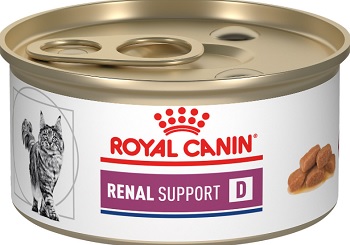
Buy On Chewy Buy On Petco
Read Our Full Brand Review
First 5 Ingredients: Water Sufficient for Processing, Chicken By-Products, Chicken Liver, Pork Liver, Wheat Flour
This gravy-style food from Royal Canin receives consistently positive reviews and doesn't seem to share the palatability problem that most kidney formulas face.
It has a chunky consistency that most cats seem to love. Remember, however, that cats with poor dental health may have trouble eating the morsels.
The food is 30% protein and 0.44% phosphorus on a dry matter basis, helping control toxic buildup in the bloodstream. It uses what Royal Canin describes as a "carefully curated antioxidant complex" to keep your cat's kidneys functioning as well as they can.
Fish oil adds omega-3 fatty acids and helps control inflammation.
Ingredients
Water Sufficient For Processing, Chicken By-Products, Chicken Liver, Pork Liver, Chicken, Wheat Flour, Vegetable Oil, Powdered Cellulose, Pork Plasma, Modified Corn Starch, Corn Flour, Egg Product, Natural Flavors, Fish Oil, Potassium Citrate, Calcium Carbonate, Taurine, Guar Gum, Fructooligosaccharides, Vitamins [L-Ascorbyl-2-Polyphosphate (Source Of Vitamin C), Dl-Alpha Tocopherol Acetate (Source Of Vitamin E), Thiamine Mononitrate (Vitamin B1), Niacin Supplement, Biotin, D-Calcium Pantothenate, Riboflavin Supplement, Pyridoxine Hydrochloride (Vitamin B6), Vitamin B12 Supplement, Folic Acid, Vitamin D3 Supplement], Choline Chloride, Citric Acid, Salt, Sodium Silico Aluminate, Trace Minerals [Zinc Proteinate, Zinc Oxide, Ferrous Sulfate, Copper Sulfate, Manganous Oxide, Sodium Selenite, Calcium Iodate], Sodium Carbonate, Marigold Extract (Tagetes Erecta L.), Magnesium Oxide.
Guaranteed Analysis

Crude Protein: 10%
Crude Fat: 6.5%
Crude Fiber: 1.7%
Moisture: 78.5%
Dry Matter Basis

Protein: 46.51%
Fat: 30.23%
Fiber: 7.91%
Carbs: 15.35%
Caloric Weight Basis

Protein: 34.38%
Fat: 54.27%
Carbs: 11.35%
What We Liked:
- Maximized energy density to help keep cats strong and muscular
- Contains omega-3 fatty acids to reduce inflammation
- Low phosphorus levels help your cat feel better
- Low protein helps to limit urea waste
What We Didn't Like:
- Many cats prefer pâté-style food
#2 Best Paté: Hill's Prescription Diet k/d Kidney Care with Chicken Canned Cat Food Review

Buy On Chewy
Read Our Full Brand Review
First 5 Ingredients: Water, Pork Liver, Chicken, Egg Product, Brewers Rice
If your cat prefers pâté-style food, this product from Hill's may be a good choice. It has a soft, smooth consistency that's easy to water down for more hydration and easier eating.
According to Hill's, this pâté-style canned cat food is "clinically tested to improve and lengthen the quality of life." It achieves this by ticking all the standard kidney disease diet boxes.
The phosphorus content of this food is restricted to 0.49% on a dry matter basis, and the protein is 30% on a dry matter basis.
Ingredients
Water, Pork Liver, Chicken, Egg Product, Brewers Rice, Sugar, Chicken Fat, Chicken Liver Flavor, Modified Rice Starch, Powdered Cellulose, Fish Oil, Calcium Sulfate, Potassium Citrate, Guar Gum, Soybean Oil, Natural Flavor, Caramel color, vitamins (Vitamin E Supplement, Thiamine Mononitrate, Niacin Supplement, Ascorbic Acid (source of Vitamin C), Pyridoxine Hydrochloride, Calcium Pantothenate, Vitamin B12 Supplement, Vitamin A Supplement, Riboflavin Supplement, Biotin, Folic Acid, Menadione Sodium Bisulfite Complex (source of Vitamin K), Vitamin D3 Supplement), Taurine, Dicalcium Phosphate, Potassium Chloride, L-Arginine, L-Carnitine, minerals (Zinc Oxide, Ferrous Sulfate, Manganese Sulfate, Copper Sulfate, Calcium Iodate), Choline Chloride, Beta-Carotene.
Guaranteed Analysis

Crude Protein: 6%
Crude Fat: 4%
Crude Fiber: 1.5%
Moisture: 88.5%
Dry Matter Basis

Protein: 52.17%
Fat: 34.78%
Fiber: 13.04%
Caloric Weight Basis

Protein: 38.18%
Fat: 61.82%
What We Liked:
- Controlled phosphorus levels
- Added omega-3 fatty acids for anti-inflammatory effect
- Calorie-dense to support muscle mass
- Highly palatable
What We Didn't Like:
- Contains sugar
- Contains caramel color
#3 Best Alternative Choice: Purina Pro Plan Veterinary Diets NF Kidney Function Advanced Care Formula Canned Cat Food Review
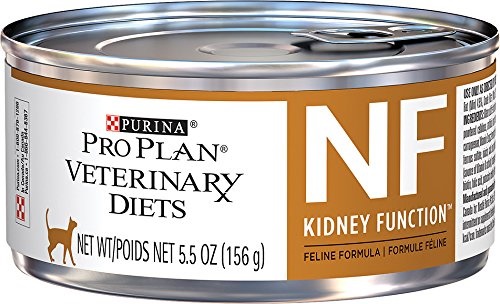
Buy On Chewy Buy On Amazon
Read Our Full Brand Review
First 5 Ingredients: Water Sufficient For Processing, Beef, Poultry By-Products, Rice, Meat By-Products
Available only with a veterinary prescription, this food from Purina does everything a standard renal diet does. It has controlled levels of protein, low phosphorus, and reduced sodium. Added B-complex vitamins help to break down nutrients and help your cat feel better.
Of the prescription foods we've reviewed, this one has the most inconsistent customer feedback. About 83% of Chewy reviewers say they'd recommend it to a friend. Some of the reviewers said that, since the food's formula changed, the food has a dense consistency that their cats don't like.
On a dry matter basis, the formula is approximately 0.49% phosphorus and 34% protein.
Ingredients
Water, Meat By-Products, Chicken Hearts, Rice, Powdered Cellulose, Pork Fat (Preserved With TBHQ And Citric Acid), Salmon, Calcium Gluconate, Glycine, Inulin, Natural Flavor, Potassium Chloride, Fish Oil, Guar Gum, Potassium Citrate, Magnesium Sulfate, Salt, Vitamin E Supplement, Carrageenan, Taurine, Choline Chloride, Thiamine Mononitrate (Vitamin B-1), Zinc Sulfate, Ferrous Sulfate, Niacin (Vitamin B-3), Calcium Pantothenate (Vitamin B-5), Vitamin A Supplement, Menadione Sodium Bisulfite Complex (Vitamin K), Copper Sulfate, Manganese Sulfate, Pyridoxine Hydrochloride (Vitamin B-6), Riboflavin Supplement (Vitamin B-2), Vitamin B-12 Supplement, Biotin (Vitamin B-7), Folic Acid (Vitamin B-9), Potassium Iodide, Vitamin D-3 Supplement, Sodium Selenite. C253420.
Guaranteed Analysis

Crude Protein: 6%
Crude Fat: 4%
Crude Fiber: 3%
Moisture: 77%
Ash: 2.5%
Dry Matter Basis

Protein: 26.09%
Fat: 17.39%
Fiber: 13.04%
Carbs: 32.61%
Caloric Weight Basis

Protein: 25.85%
Fat: 41.85%
Carbs: 32.31%
What We Liked:
- Low in phosphorus
- Highly palatable
- Calorie dense to support lean body mass
What We Didn't Like:
- Contains carrageenan, which may create inflammation
- No omega-3 supplementation
#4 Best Raw Food: Darwin's Natural Intelligent Design™ KS Kidney Support Raw Cat Food
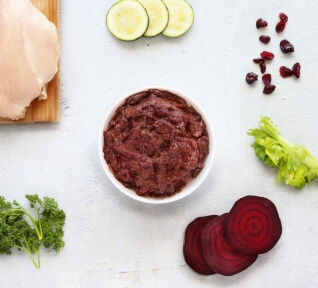
Buy On Darwin's
Read Our Full Brand Review
First 5 Ingredients: Chicken Thigh Meat, Turkey Hearts, Chicken Hearts, Beets, Zucchini
This raw cat food is a bit different from the other prescription diets on our list. Instead of focusing on low protein levels, this food maintains a normal level of protein and approaches kidney disease from a different angle.
The food is relatively low in phosphorus, with 0.9 grams per 1,000 calories. It's not as low as some renal diets, but just below the recommended 1.25 grams per 1,000 calories for healthy cats.
Additionally, it contains chitosan and elevated calcium. The former is a salivary phosphate binder that helps to limit the amount of phosphorus the body can absorb. Higher levels of calcium also reduce phosphorus absorption.
Like the other foods on this list, the food has elevated levels of B-complex vitamins and omega-3 fatty acids for reduced inflammation.
Though it doesn't have a strong base of customer reviews, this recipe shows promise as an unconventional, carnivore-appropriate alternative to traditional renal diets.
Be aware that the meat in raw diets can contain bacteria that cause foodborne disease. Your cat's health is already in a somewhat fragile state because of kidney disease, so talk with your veterinarian before feeding your cat a raw diet.
Ingredients
Chicken Thigh Meat, Turkey Hearts, Chicken Hearts, Beets, Zucchini, Turkey Livers, Chicken Livers,Celery, Fish Oil, Egg Whites, Parsley, Gelatin, Oyster Shell Pwdr, Cod Liver Oil, Dandelion Root Pwdr, lnulin, Turmeric, Potassium Chloride, Spirulina, Taurine, Tomato Pomace, Vitamin E,Cranberry Pwdr, Chitosan, Magnesium Proteinate, Choline Chloride, Iron Proteinate, Zinc Proteinate, Cinnamon, Sea Salt, Thiamine Mononitrate, Aloe Vera, Vitamin Bl 2, Black Pepper, Selenium Proteinate, Folic Acid, Manganese Proteinate, Vitamin B2, Vitamin B6 (Pyridoxine), Iodine
Guaranteed Analysis

Crude Protein: 9%
Crude Fat: 6%
Crude Fiber: 1%
Moisture: 78%
Dry Matter Basis

Protein: 40.91%
Fat: 27.27%
Fiber: 4.55%
Carbs: 27.27%
Caloric Weight Basis

Protein: 30.43%
Fat: 49.28%
Carbs: 20.29%
What We Liked:
- Restricted phosphorus content
- Added omega-3 fatty acids
- Elevated levels of B-complex vitamins
- Rich in biologically-available animal protein
What We Didn't Like:
- Darwin's Natural Pet foods have been recalled several times
#5 Best Dry Cat Food: Royal Canin Veterinary Diet Renal Support F Dry Cat Food Review

Buy On Chewy Buy On Petco
Read Our Full Brand Review
First 5 Ingredients: Corn, Chicken Fat, Pork Meal, Brewers Rice, Corn Gluten Meal
High-moisture food is ideal for all cats. It's even more valuable for cats with kidney disease. Cats in renal failure are prone to dehydration, and feeding them a water-depleted diet does nothing to help. Feeding your cat a dry diet may have you giving him subcutaneous fluid injections sooner than these injections would otherwise be necessary.
Dr. Lisa Pierson puts it into perspective in this quote from an interview conducted by Dr. Karen Becker of Mercola Healthy Pets:
"There's nothing that frustrates me more than to see cat owners leave their vet's office with a bag of fluids under one arm and a bag of dry food under the other arm. They've been told to feed a water-depleted diet and then stick a needle in their cat's back to put water into him. That's pretty nonsensical."
That said, our top priority is getting your cat to eat. If dry food is all your cat wants to eat, it's better than nothing. For cats who insist on dry food, this prescription kibble from Royal Canin would be a good option to consider. It has low protein, restricted phosphorus, and supplemental EPA and DHA from fish oil.
Its protein content sits somewhere between 24.5% and 28.8% on a dry matter basis, with up to about 0.59% phosphorus on a dry matter basis.
On Chewy, the food has a 4.7 out of 5-star rating, and 97% of reviewers say they would recommend the food to a friend.
Ingredients
Brewers Rice, Corn, Wheat Gluten, Chicken Fat, Pork Digest, Pea Fiber, Corn Gluten Meal, Natural Flavors, Dried Chicory Root, Fish Oil, Calcium Carbonate, Vegetable Oil, Potassium Citrate, Sodium Silico Aluminate, Sodium Pyrophosphate, Potassium Chloride, Dl-Methionine, Powdered Psyllium Seed Husk, Fructooligosaccharides, Choline Chloride, Salt, Taurine, Vitamins [Dl-Alpha Tocopherol Acetate (Source Of Vitamin E), L-Ascorbyl-2-Polyphosphate (Source Of Vitamin C), Niacin Supplement, Biotin, Riboflavin Supplement, D-Calcium Pantothenate, Pyridoxine Hydrochloride (Vitamin B6), Vitamin A Acetate, Thiamine Mononitrate (Vitamin B1), Vitamin B12 Supplement, Folic Acid, Vitamin D3 Supplement], Calcium Sulfate, L-Lysine, Trace Minerals [Zinc Proteinate, Zinc Oxide, Ferrous Sulfate, Manganese Proteinate, Manganous Oxide, Copper Sulfate, Calcium Iodate, Sodium Selenite, Copper Proteinate], Marigold Extract (Tagetes Erecta L.), Rosemary Extract, Preserved With Mixed Tocopherols And Citric Acid.
Guaranteed Analysis

Crude Protein: 28%
Crude Fat: 15%
Crude Fiber: 5.9%
Moisture: 8%
Dry Matter Basis

Protein: 30.43%
Fat: 16.3%
Fiber: 6.41%
Carbs: 46.85%
Caloric Weight Basis

Protein: 26.04%
Fat: 33.88%
Carbs: 40.08%
What We Liked:
- Omega-3 fatty acids from fish oil help reduce inflammation
- Controlled phosphorus helps your cat feel healthier
- Customers report that the square kibble is easy for their senior cats to eat
- Restricted protein helps to lower urea waste
- Unlike some other prescription renal diets, the food is free of artificial colors or added sweeteners
What We Didn't Like:
- Lacks the moisture your cat needs
- High carbohydrate content
- Slightly more expensive than other dry prescription foods
The 3 Best Non-Prescription Foods for Cats with Kidney Disease: Our Recommendations
#1 Overall Best Non-Prescription: Weruva TruLuxe Grain-Free Steak Frites with Beef & Pumpkin in Gravy

Buy On Chewy Buy On Amazon
Read Our Full Brand Review
First 5 Ingredients: Water Sufficient for Processing, Beef, Pumpkin, Sweet Potato, Carrot
Since this food doesn't target CKD specifically, it may not be a good choice for cats with advanced renal disease. However, it has several qualities that make it a good option for cats in the early stages of kidney failure—remember that you won't start seeing symptoms until your cat's lost a significant amount of kidney function. And since all older cats fall into the at-risk category, this food is a good choice for healthy seniors.
The food is rich in biologically-available protein from beef but, unlike most protein-rich foods, it's relatively low in phosphorus. With 0.57% phosphorus on a dry matter basis, this food is on par with some prescription diets.
Remember— this isn't a renal diet. It doesn't have elevated levels of B vitamins, low sodium, or added omega-3 fatty acids from fish oil.
Ingredients
Beef Broth, Beef, Pumpkin, Sweet Potato, Potato Starch, Carrot, Sunflower Seed Oil, Tricalcium Phosphate, Xanthan Gum, Potassium Chloride, Choline Chloride, Salt, Taurine, Zinc Sulfate, Vitamin E Supplement, Nicotinic Acid (Vitamin B3 Supplement), Ferrous Sulfate, Manganese Proteinate, Calcium Pantothenate, Thiamine Mononitrate, Vitamin A Supplement, Riboflavin Supplement (Vitamin B2), Pyridoxine Hydrochloride (Vitamin B6), Vitamin D3 Supplement, Folic Acid, Copper Sulfate, Menadione Sodium Bisulfite Complex (Source Of Vitamin K), Potassium Iodide, Sodium Selenite, Biotin, Vitamin B12 Supplement.
Guaranteed Analysis

Crude Protein: 10%
Crude Fat: 1.3%
Crude Fiber: 0.5%
Moisture: 86%
Dry Matter Basis

Protein: 71.43%
Fat: 9.29%
Fiber: 3.57%
Carbs: 15.71%
Caloric Weight Basis

Protein: 65.12%
Fat: 20.56%
Carbs: 14.33%
What We Liked:
- Low in phosphorus, which may help prevent and ease the symptoms of kidney disease
- Rich in easily-digestible animal protein
- Low carbohydrate content
- Free of potentially inflammatory ingredients
What We Didn't Like:
- Doesn't contain any fish oil or other sources of omega-3 fatty acids
- Expensive
- Not formulated for cats with kidney disease
#2 Runner-Up: Blue Natural Veterinary Diet KM Kidney + Mobility Support Canned Cat Food
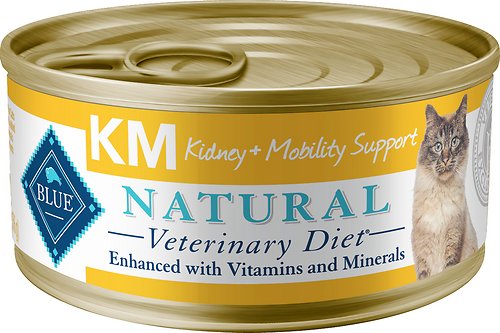
Buy On Chewy Buy On Amazon
Read Our Full Brand Review
First 5 Ingredients: Chicken, Chicken Broth, Water, Potatoes, Potato Starch
Although this food is called a "Veterinary Diet," you can purchase it without a veterinarian's prescription. In addition to standard renal diet features, this food is formulated with glucosamine and chondroitin for joint health support.
Note that glucosamine and chondroitin probably don't have the record of success you think they do. Indeed, a closer look at the research suggests that they may not help cats with joint issues at all.
The pâté-style food gets mixed taste test results – a notable percentage of reviewers say that their cats didn't like the food.
Compared to other renal care products, this food has slightly more phosphorus and less protein on a dry matter basis. It's 0.77% phosphorus and about 28% protein on a dry matter basis.
Ingredients
Chicken, Chicken Broth, Water, Potatoes, Potato Starch, Beef, Chicken Liver, Carrots, Pea Fiber, Sweet Potatoes, Potassium Citrate, Fish Oil (source of Omega 3 Fatty Acids), Natural Flavor, Flaxseed, Guar Gum, Taurine, Cassia Gum, Carrageenan, Salt, Calcium Carbonate, Blueberries, Cranberries, Choline Chloride, Iron Amino Acid Chelate, Zinc Amino Acid Chelate, L-Carnitine, Glucosamine Hydrochloride, Chondroitin Sulfate, Vitamin E Supplement, Thiamine Mononitrate (Vitamin B1), Copper Amino Acid Chelate, Manganese Amino Acid Chelate, Sodium Selenite, Niacin Supplement (Vitamin B3), Calcium Pantothenate (Vitamin B5), Pyridoxine Hydrochloride (Vitamin B6), Riboflavin Supplement (Vitamin B2), Vitamin A Supplement, Biotin (Vitamin B7), Potassium Iodide, Vitamin D3 Supplement, Vitamin B12 Supplement, Folic Acid (Vitamin B9), preserved with Mixed Tocopherols.
Guaranteed Analysis

Crude Protein: 4.5%
Crude Fat: 3%
Crude Fiber: 3%
Moisture: 78%
Ash: 2%
Dry Matter Basis

Protein: 20.45%
Fat: 13.64%
Fiber: 13.64%
Carbs: 43.18%
Caloric Weight Basis

Protein: 21.14%
Fat: 34.23%
Carbs: 44.63%
What We Liked:
- Restricted phosphorus content
- Added omega-3 fatty acids
- Supports joint health
What We Didn't Like:
- Contains carrageenan, which may create inflammation
- Higher in phosphorus than some other foods
#3 Best Budget: Weruva Wx Phos Focused Natural Wet Cat Food – Tilapia & Tuna Formula in a Hydrating Purée
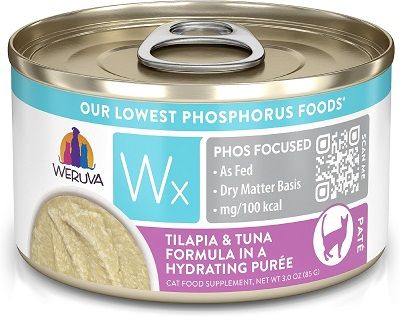
Buy On Chewy Buy On Amazon
Read Our Full Brand Review
First 5 Ingredients: Meat By-Products, Sufficient Water for Processing, Beef, Chicken, Animal Liver Ocean Fish
This food's selling point is packing all the key features of a kidney disease diet into a budget-friendly meal that you can buy without a vet's prescription.
And though it doesn't nail everything, it seems to do a pretty good job of it. At just over a dollar a can, this food gives you relatively low phosphorus content, restricted protein, and high calorie density.
Neo's phosphorus content is about 0.16% on a dry matter basis, so it's slightly higher in phosphorus than other formulas. If your cat refuses to eat a lower-phosphorus recipe, you might try this one instead.
In addition to lower-than-average phosphorus, the food has restricted protein content: 11% on a dry matter basis.
Ingredients
Fish Broth, Tilapia, Tuna, Egg White, Chicken Fat (Preserved with Mixed Tocopherols), Sunflower Oil, Natural Flavor, Fish Oil, Egg Shell Meal, Agar-Agar, Choline Chloride, Taurine, Zinc Sulfate, Vitamin E Supplement, Ferrous Sulfate, Thiamine Mononitrate (Vitamin B1), Niacin Supplement (Vitamin B3), Calcium Pantothenate, Vitamin A Supplement, Manganese Sulfate, Copper Sulfate, Riboflavin Supplement (Vitamin B2), Pyridoxine Hydrochloride (Vitamin B6), Vitamin D3 Supplement, Folic Acid, Vitamin B12 Supplement, Menadione Sodium Bisulfite Complex (Source Of Vitamin K), Potassium Iodide
Guaranteed Analysis

Crude Protein: 10%
Crude Fat: 6%
Crude Fiber: 1%
Moisture: 82%
Ash: 1.5%
Dry Matter Basis

Protein: 55.56%
Fat: 33.33%
Fiber: 5.56%
Caloric Weight Basis

What We Liked:
- Limited phosphorus
- Some reviews indicate that it's highly palatable
- Calorie dense to support healthy muscle mass
What We Didn't Like:
- Doesn't contain an omega-3 supplement
- Slightly higher in phosphorus than some other foods
- Contains carrageenan, which may contribute to inflammation
Above All, Cats With Chronic Kidney Disease Need To Eat.
From Dr. David J. Polzin, DVM, Ph.D., DACVIM's 11 Guidelines for Conservatively Treating Chronic Kidney Disease: "In many or most dogs and cats with chronic kidney disease, death or euthanasia results directly or indirectly from starvation."
The dietary recommendations above apply only to cats who are still eating. But if the disease has progressed to a point where your cat is no longer interested in food, nutritional rules go out of the window. If your cat is refusing to eat, don't worry about feeding a therapeutic diet. Any food he's willing to eat is good food.
Consider Giving Your Cat High-calorie Supplements.
In addition to traditional food, consider giving your cat high-calorie supplements. High-calorie gels and treats help to curb weight loss and keep your cat feeling as well as possible. Consider nutritional gels like Tomlyn Nutri-Ca and Vetoquinol Nutri-Cal.
Food toppers, broths, and treats can also help. Some cats, especially those with poor dental health, may be willing to eat baby food.
You Might Also Consider Supplementing Your Cat's Diet With A Probiotic.
When bacteria and endotoxins enter the gut, probiotics may help to perform "enteric dialysis," taking on some of the detoxifying function that the kidneys have lost.
Azodyl is a synergized prebiotic and probiotic supplement designed for cats with kidney disease. The supplement contains patented strains of Enterococcus thermophilus, Bifidobacterium longum, and Lactobacillus acidophilus. The three probiotics are synergized with psyllium husk, a source of prebiotic fiber.
While it's not clear that Azodyl will help, it does show some promise. If you're not willing to spend over $70 a bottle for the putative benefits of Azodyl, consider supplementing with another probiotic.
Talk to your veterinarian before giving your cat any supplements. Your vet can help you determine which supplements could help your cat and instruct you on how to give them.
Read Our Guide To The Best Probiotics On The Market
Here Are A Few Additional Resources To Help You Out
These resources may help you learn more about feline kidney disease and decide which foods are right for your cat.
FelineCRF.org
Also known as Tanya's Comprehensive Guide to Feline Chronic Kidney Disease, this site is an extraordinary free resource for cat guardians. Though not written by a veterinarian, the site's informative content has been endorsed by vets and veterinary specialists. The massive site contains over a thousand pages of information and covers almost everything you need to know about this disease and its treatment.
If you prefer, you can also buy the paperback version of the site—the 630-page book is available on Amazon at around $36.99.
Cat Food Database
As your cat's kidney disease progresses, you'll probably have to pry out his appetite with a variety of foods. The following databases may help you to evaluate your options based on CKD-relevant metrics.
Click here to browse FelineCRF.org's food databases of dry and canned products sold in the US and UK.
An Interview with Dr. Lia Pierson
In this 34-minute interview, well-known veterinarians Dr. Karen Becker and Dr. Lisa Pierson explore the causes and treatment of kidney disease in cats. Pierson's common-sense approach is a calm in the storm of confusion that is CKD.
Source: https://allaboutcats.com/best-cat-food-for-kidney-disease
0 Response to "What to Feed Senior Cats With High Bun"
Post a Comment